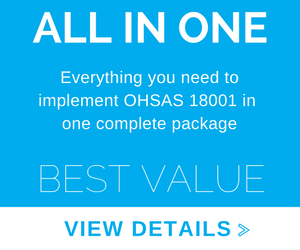Corrective and Preventive Action (CAPA) Explained
- ISO 9000 Definition (referenced in OHSAS 18001/18002)
- Expanded Definitions
- Differences between CA/PA and Correction
- Simple Example of Correction, CA, and PA
- CAPA Training
A critical requirement of OHSAS 18001 is corrective & preventive action (Sec. 4.5.3.2), and we are often asked the difference. Here is a quick evaluation and example to help you:
ISO 9000:2015 Sec. 3.6 is used to define them in OHSAS 18001 3.4 & 3.18 as follows:
- Correction – Action to eliminate a detected nonconformity
- Corrective action – Action to eliminate the cause of a detected nonconformity
- Preventive action – Action to eliminate the cause of a potential nonconformity
Lets expand on these definitions a bit
Correction: When a problem occurs, you need to keep several aspects in mind.
- Determine the magnitude of the problem.
- Determine how to prevent it from getting bigger.
- How to address current situation.
You could call this – Damage Control. Although thiscorrection takes steps to correct the problem it has no bearing on cause.
Corrective Action: Now determine if the importance of the situation requires further action:
- Was it a big deal?
- What is the chance it will happen again?
- Estimate of any future threat
The causes need to be looked into to prevent recurrence if it was a big deal.
Preventive Action: First you need to assess the risk and mitigate it based upon severity. The following tools are helpful: Source: Carnegie Mellon University
- Checklists
- FMEA – Failure mode & effects analysis
- Hazard and operability analysis (HAZOP)
- Fault tree analysis (FTA)
OHSAS 18001 Corrective/Preventive Action Guide
This CAPA Process Guide is a time-tested outline for developing or improving your corrective action/preventative action approach (CAPA). For instance, the guide helps you develop each phase of the process including:
- Record Potential or Actual Non-conformance
- Assign and Manage Request
- Investigate Root Cause
- Design Corrective Action
- Implement Corrective Action
- Follow-Up on Corrective Action to Assure Effectiveness
- Correction & Corrective Action-
- HIGH risk/impact/frequency
- Correction fixes the CURRENT set of issues
- Corrective action prevents it from happening again by looking at causes
- LOW risk/impact actions are similar since likelihood of reccurrence is low
- HIGH risk/impact/frequency
- Corrective & Preventive Action – the damage is already done in corrective action
Simple Example to demonstrate the differences
A customer orders 500 parts, but only 450 are delivered.
- Correction – Fix the current issue
- get the customer 50 more parts
- Corrective Action – Why were we short?
- Operator miscounted 9 boxes of 50 as 10 boxes of 50
- Preventive Action – make sure it doesn’t happen again
- Weigh products on scale so you know if quantity is met
OHSAS 18001 requires the organization to have a documented procedure for corrective an preventive action.
Note: The combination of corrective action and preventive action documented procedures into a single OHSMS document is acceptable, but is not recommended. If these are combined, then it is important to verify that the organization understands clearly the difference between the intent of corrective and preventive actions.
Take Root Cause Analysis with Corrective Action Training!




